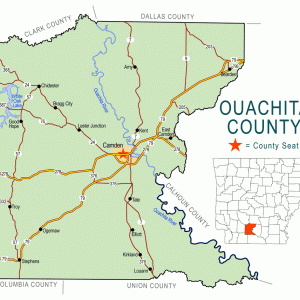calsfoundation@cals.org
Ogemaw (Ouachita County)
Ogemaw is an unincorporated community located in Ouachita County about four miles northeast of Stephens (Ouachita County) and fourteen miles southwest of Camden (Ouachita County). The community was founded to support timber operations in the area, but the local economy evolved in the early twentieth century with the discovery of oil nearby.
Early settlers in the area included Thomas Meredith, who obtained more than 200 acres from the land patent office in 1859. Thomas lived with his wife, Mary, and their ten children on the property. They were served by the post office in the nearby community of Seminary (Ouachita County).
The Cotton Belt Railroad began operations in the area around 1882. With the construction of the railroad and the founding of Stephens, the population began to increase.
The early name for the community was Evans. A post office with this name opened in 1890 but closed after just over a year of operation and was consolidated with the office in Buena Vista (Ouachita County).The M. A. Johnson Lumber Company began operations near the community in 1889, but the business failed in 1891. On October 17, 1891, Charles Potts took over the business. As the lumber business grew, a number of businesses opened.
The Ogemaw Post Office opened in 1892, with Charles Potts as the postmaster. The name of the community was selected by Potts and is shared with communities in Michigan, Wisconsin, Minnesota, and elsewhere. Ogemaw is translated as “chief” from the language of the Ojibwe. The first office was in the same location as the former Evans office. The post office ceased operations in 1968, and the Stephens Post Office took responsibility for the area.
By 1900, Ogemaw had a population of around 500. Businesses in the area at that time included at least three general stores, a physician’s office, two sawmills, a shingle mill, and two hotels. The economy of Ogemaw and much of southern Arkansas changed with the drilling of the Lester and Haltom Well Site Number 1 on April 14, 1920. Located about one mile south of Ogemaw, the well produced between 70 and 100 barrels of oil a day for a few months before it ceased production. The last well drilled in the area reached a depth of 6,000 feet in 1983, but no oil was found.
Constructed around 1895, the first white school in Ogemaw operated until 1924, when it was replaced by a new building. These buildings were known in the community as the “old” and “new” schools. It is unclear when the African-American school began operations in Ogemaw, but it is likely that students began attending the school soon after the white school opened. The African-American school was named Mount Pleasant and served the community until the 1930s, when it burned. A replacement building was then constructed. White students could complete the ninth grade at Ogemaw before transferring to either Buena Vista or Stephens. African-American students transferred to Stephens after the eighth grade. The enrollment at the white school fell to an average of two students per grade in 1941, and all transferred to Stephens. An official effort to consolidate the school district failed in 1944, and it is unclear when the district officially consolidated. Mount Pleasant closed in 1952, and the students from the school also transferred to Stephens.
H. L. Holt opened a store in 1896, as he held interests in several timber operations nearby. Residing in Junction City (Union County) at the time of the construction of the store, he moved to Ogemaw in 1914 after a fire destroyed his lumber mill in Junction City. The next year, Holt received an appointment as postmaster, and the store doubled as the post office. Upon his retirement in 1940, his daughter and son-in-law, Chester Poindexter, began operating the store, which was renamed Poindexter Grocery. Upon his father’s death in 1983, Kenneth Poindexter took over operations of the store. Under the name Holt-Poindexter Store, it was added to the National Register of Historic Places on October 23, 1986.
The timber companies in Ogemaw ceased major operations by 1948, although a new company called American Pulpwood Company operated in the area in the late 1970s and early 1980s. The school consolidated with Stephens in 1945. Little remains of the community in the twenty-first century.
For additional information:
“‘Black Gold’ in Arkansas First Found at Ogemaw.” Ouachita County Historical Quarterly 18 (March 1987): 23.
“Holt-Poindexter Store.” National Register of Historic Places nomination form. On file at Arkansas Historic Preservation Office, Little Rock, Arkansas. Online at http://www.arkansaspreservation.com/National-Register-Listings/PDF/OU0085.nr.pdf (accessed November 20, 2020).
“Ogemaw.” Ouachita County Historical Society. http://www.ouachitacountyhistoricalsociety.org/uploads/3/4/6/4/34649652/ogemaw.pdf (accessed November 20, 2020).
Poindexter, Kenneth. “Old Ogemaw Store on National Register.” Ouachita County Historical Quarterly 18 (March 1987): 4–11.
———. “School Bells Tolled at Ogemaw for More than Half-a-Century.” Ouachita County Historical Quarterly 18 (March 1987): 16–22.
“Post Offices at Evans and Ogemaw.” Ouachita County Historical Quarterly 18 (March 1987): 14–15.
David Sesser
Henderson State University
 Ouachita County Map
Ouachita County Map 



Comments
No comments on this entry yet.